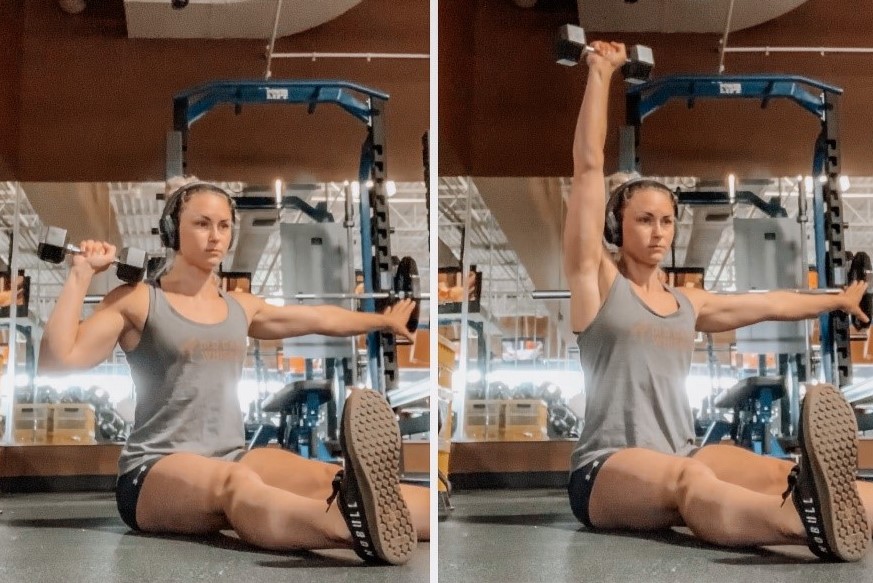
By Alyssa Parten |
Upper- and lower-body unilateral exercises are commonly prescribed in athletics, recreational resistance training, and rehabilitation settings. Among the benefits associated with incorporating one-sided exercises are increased joint stability, neuromuscular coordination, and bilateral strength. Additionally, unilateral exercises have been linked to improving muscle strength, force, size symmetry, ground reaction force generation, and sport-related skills. Depending on the exercise selected, unilateral and asymmetrical exercises have shown to strengthen muscles of the trunk, trunk stability, deep muscle groups of the hip, and muscles of the back. Taken a step further, if the unilateral exercise prescribed requires creating core stiffness, the adaptive effect is improved spine stability and injury resilience to the vulnerable structure.
When performing exercises of unilateral (one limb moving without the assistance of the other) or asymmetrical (one limb doing the majority of the work, with the other assisting in balance) in nature, the increased stability requirements to maintain control of the movement has proven to be an effective method of enhancing neuromuscular coordination. With an increase in neuromuscular control, greater motor unit activation is developed. This enhancement in motor-unit recruitment then influences stability of the joints through an increase in coordinated muscle co-contractions. Further, the enhanced motor-unit recruitment and muscle co-contraction efficiency may inevitably develop greater strength in bilateral movements and sport-related skills, with consideration in movement and mechanical specificity. In regards to muscle strength, force, and size symmetry, it is important to note that every individual has a “dominant side” and perfect symmetry between limbs is not possible. However, when asymmetrical deficits exceed 15%, research supports the need to focus on unilateral training to reduce the gap and minimize the deleterious risks associated with large imbalances. These risks include impaired performance and increased risk for injuries. In effort to improve both symmetry and sport-related performance, unilateral/asymmetrical exercises that resemble the mechanics, forces, and neuromuscular requirements (such as the eccentric component) of sport skills may be an effective strategy.
Many musculotendinous injuries are thought to be a consequence of neuromuscular deficits and altered length-tension relationships, potentially contributing to over-use injuries, as well. The evidence on unilateral/asymmetrical training supports their inclusion in rehabilitation settings. Unilateral/asymmetrical exercises may also be an appropriate and beneficial method in restoring strength following an acute or chronic injury, due to the lower external loads required to stimulate muscle activation and the decreased stress placed on the spine. For individuals who are not experiencing any neuromuscular troubles (of which they are aware) and are currently free of injury, utilizing unilateral and/or asymmetrical exercises may still be an integral component to their strength program, to enhance coordination, stability, symmetry, and mitigate manifestation of musculotendinous injuries.
Improvement in neuromuscular control, muscle activation, bilateral strength, maintenance or improved symmetry, and musculotendinous health can certainly go far in any strength, power, and team sport athletes, as well as anyone seeking to improve their quality of life and movement function. While there are many advantages in employing unilateral movements, they should be considered in addition to bilateral exercises, rather than in place of, due to the substantial decrease in external load possible during unilateral exercises in comparison to their bilateral counterparts. To maximize the benefits associated with unilateral training in conjunction with strength, muscle, and performance adaptations, both one-sided and double-sided training are essential to a training program.
A Few of My Favorites:
- Single-Arm Dumbbell or Kettlebell Z Press
- Primarily Targets: Deltoid, Triceps, Upper/Mid Trapezius, Trunk/Core Stabilizers

- Cossack Squats (Asymmetrical Exercise)
- Primarily Targets: Hamstrings, Adductors, Gluteals, Abductors, External Rotators

- Cable Row to Upward Rotation
- Primarily Targets: Posterior Deltoid, Rotator Cuff, Rhomboid Major/Minor

- Single-Leg Box Squat
- Primarily Targets: Gluteus Maximus, Hamstrings, Quadriceps, Trunk/Core Stabilizers
Alyssa Parten is an NSCA-CSCS and USAPL certified personal trainer and powerlifting coach from Birmingham, Alabama. She received her Bachelors in Exercise and Sport Science from The University of Alabama and is currently pursuing a double Masters at the University of Concordia Chicago in Human Movement Science and Strength & Conditioning. Currently, she works in a studio personal training gym as a personal trainer and strength coach and owns an online powerlifting coaching business, Ladybeef Inc. Additional certifications include: Precision Nutrition Level 1, TPI Level 1, and Human Movement Specialist.
Website: www.ladybeef.com | Instagram: @alyssaparten | Email: alyssa@ladybeef.com
[…] Dumbbell lunges are programmed to help us build unilateral strength. […]
Good 😊